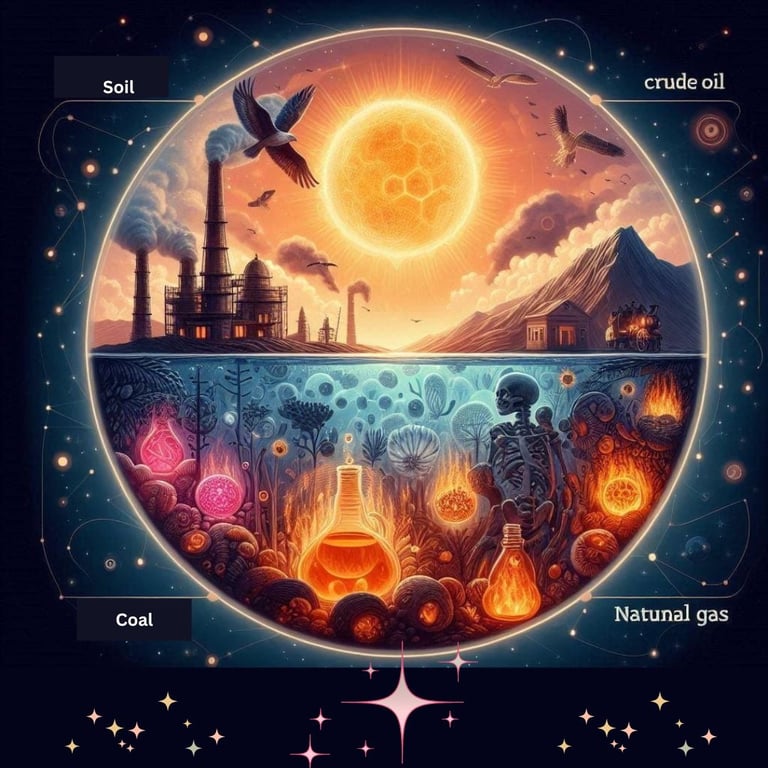Fossil Fuels Leads To Global Warming
Anshita Agarwal
University of Petroleum and Energy Studies (UPES), Dehradun
This blog is written by Anshita Agarwal, a Fourth-year law student of University of Petroleum and Energy Studies (UPES), Dehradun


INTRODUCTION
For nearly a century, majority of the energy required to run vehicles, machines in our businesses and lights in our homes is generated from burning of fossil fuels. Even Today, 80% of our energy requirements are satisfied by gas, coal, oil etc.
The use of fossils fuels has detrimental effects on the environment and human kind, which includes Global warming, air, and water pollution etc. Through this blog we shall come to know what constitutes a fossil Fuels, impact of Fossil Fuel combustion on Environment, the hidden expenses associated with it and why the idea of switching to renewable energy is imperative.
WHAT ARE FOSSIL FUELS?
Fossil Fuels are highly concentrated forms of pre-Man sunlight trapped in organic cells. Solid, liquid, and gaseous fuels like coal, crude oil and natural gas respectively are derived from ancients organic remains of fossils residing in sediments. The sediments became sedimentary rock over the eons because of which they have high carbon content. They are non- renewable and current prime source of humanity’s energy.
IMPACT OF FOSSIL FUEL COMBUSION ON OUR ENVIROMENT:
According to a new study it was discovered that the main source of air pollution in Himalayas is because of burning of Fossils fuel, which is contributing even more than that of burning of biomass to global warming. Researchers carried out a comprehensive investigation into carbonaceous aerosols, which includes “Black Carbon” and “Organic Carbon” , in the Himalayas. They found that Fossil Fuels combustion emits more amount of BC than that of biomass burning , affecting more to the regional warming. The study also reveled that burning of crop residue in northern India and forest fires also contributing to air pollution.
Along with this, Fossil fuels emit more than just carbon dioxide when burned. Coal-fired power plants single-handedly generate 35 percent of dangerous mercury emissions in the United States, as well as two-thirds of U.S. sulfur dioxide emissions which contribute to acid rain.
Furthermore, since the start of the Industrial Revolution, the ocean has become 30% more acidic because of directly releasing industrial waste in water bodies, because of this, the level of acid in waters increases, the amount of calcium carbonate—a substance used by oysters, lobsters, and countless other marine organisms to form shells—decreasing. This can slow growth rates, weak shells, and impact the entire food chains.
WHAT ARE THE HIDDEN COST OF FOSSIL FUELS?
“Costs accure at every point of the fossil fuel supply chain”
Extraction processes can generate air and water pollution, and can harm locam bodies. Transporting fuels from the mine or well can cause air pollution and leads to serious accidents and spills.
According to the recent updates, fossil fuels related items transport and household energy contributes about 20% to India’s annual rate of inflation between April and May 2022, according to a report published by cambridge Econometrics ‘Fossil Fuel Prices and Inflation in India’. During that period the annual Inflation rate in India was increased to 7-8% .
IS SWITCHING TO RENEWABLE ENERGY CAN BE A GOOD OPTION?
· Renewable energy sources for example, usage of solar and wind power which do not produce harmful greenhouse gases / pollution which generally occurs during burning of Fossil Fuels. This makes them a better option for the protection of the environment along with this they can easily accessible as compared to fossil fuels which are limited in supply.
· According to a study it was founded that 80% of the world’s population use fossil fuels from other countries, making them vulnerable to political problems and rapid inflation.
· These energy sources are easily accessible and can continue usage of this can provide 90% of the world’s electricity by 2050, switching to renewable energy can enable countries to eliminate usage of Fossil Fuels and help them to improve their economies.
· It is the cheapest power option across the world nowadays, which can inspire even the low- and middle-economy countries. Usage of this can provide 65% of world’s total electricity supply by 2030 at the cheapest rate. It could decarbonize 90% of power sector by 2050, massively cutting carbon emission and helping to mitigate climate change.
CONCLUSION
Hence, if we use the right policies in right place, we can make drastic progress toward achieving a clean energy future. Even, the president of US- Joe Biden has proposed a target “that the country will run on 80% clean electricity by 2030”. But, to achieve that target, we need to build up efficiency, cut off energy demand in half, increase the use of renewable energy resources in our day-to-day operations and electrify almost all forms of transportation. But to achieve these goals we will require sustained, coordinated policy efforts from all levels of government, including the private sector, and local communities. By using demonstrated clean energy technologies and resources present today, we can achieve it easily.
REFERENCES:
1. https://thelawdictionary.org/fossil-fuel/
2. https://indianexpress.com/article/india/fossil-fuel-contribute-india-annual-inflation-8450960/
3. https://dst.gov.in/new-study-unveils-significant-impact-fossil-fuels-himalayan-air-pollution
4. https://www.un.org/en/climatechange/raising-ambition/renewable-energy
5. https://www.acciona.com/renewable-energy/?_adin=11734293023
